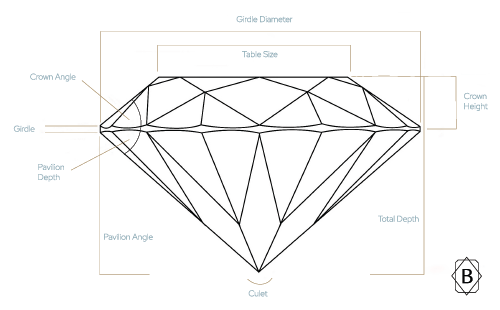Real Marquise Cut Diamonds
Carat is the unit of measurement for the physical weight of diamonds, and is one of the most objective measurements of the “Four Cs” for determining the value of a diamond. One carat is equal to 200 milligrams, or 1/5 gram, and is subdivided into 100 “points”. This allows very precise measurements to the hundredth decimal place.

Actual Diamond Size 0.50 carat on Hand
Cut refers to a diamond’s proportions, symmetry, and polish of the facets by the expert cutter. Cut does not refer to the shape of a diamond, such as cushion or princess. Cut determines a diamond’s ability to reflect and refract light, which directly affects a diamond’s beauty. With a better cut, the diamond will exhibit more fire, brilliance, and scintillation. Cut is graded by experts as Fair, Good, Very Good, Excellent, and Ideal.

A diamond's clarity refers to the presence of impurities on and within the stone and tiny imperfections might be visible. These are called flaws or inclusions. They form during the growing process and are unique to each stone. The term "eye clean" refers to diamonds whose inclusions generally cannot be seen without magnification, and are typically graded SI or higher on the clarity scale.

A grading report or diamond certificate is an independent, expert opinion on the quality of the diamond. Gemologists from the world's leading grading labs use special equipment to measure the weight and dimensions of the diamond and assess quality characteristics such as cut, color, and clarity. Bespoke Jewels only utilizes the most distinguished grading labs.Please contact us to request the grading report.
The length-to-width ratio compares the length of a diamond to its width to show how elongated a fancy-shaped diamond appears when viewed from the top. Length-to-width ratio is a matter of personal preference with some individuals preferring a more elongated shape and others a more equal or square shape. It is calculated as length divided by width.
Fluorescence refers to a diamond's tendency to emit a soft colored glow when subjected to ultraviolet light (such as a "black light"). Overall, diamond fluorescence should not be a major factor in the purchase of a diamond since its effects are negligible. Fluorescence grades include Very Strong, Strong, Medium, Faint, None.

| Shape | Carat | Color | Clarity | Cut | Report | Polish | Symmetry | DEPTH | Price | Compare | Wish | Choose |
|---|
Select your perfect diamond from thousands of ethically created diamonds, then choose a setting and we will show you your custom-made ring.
Select your ideal diamond from thousands of natural diamonds. At Bespoke Jewels we are committed to providing you with stones of the highest quality and value, so no matter what shape or size you choose, you are always getting the very best.
Diamonds are amongst the most durable known substances, which means they can last indefinitely. However, a diamond’s “lifetime” can be impacted by a number of outside factors, such as wear and damage, which can alter its appearance. Fortunately, with proper care, diamonds can retain their beauty and brilliance for several generations.
Maintaining a diamond consists mostly of regular cleaning, careful storage, and overall delicate treatment. Though diamonds are extremely durable, it is important to avoid situations of high impact and to clean them routinely to ensure they maintain their qualities.
The value of a diamond depends on several factors, including the 4Cs (carat weight, cut, color, and clarity), shape, and rarity. Diamonds with higher quality and rarity tend to hold their value better than those of lower quality or common shapes. It is important to purchase diamonds from reputable sources and have them appraised regularly to ensure their value is maintained.


